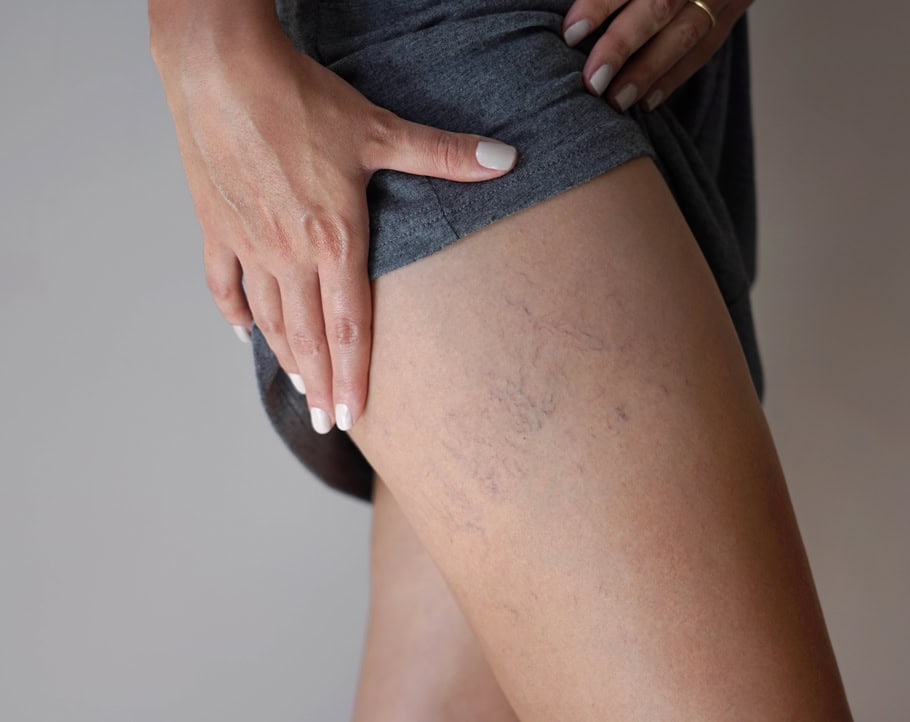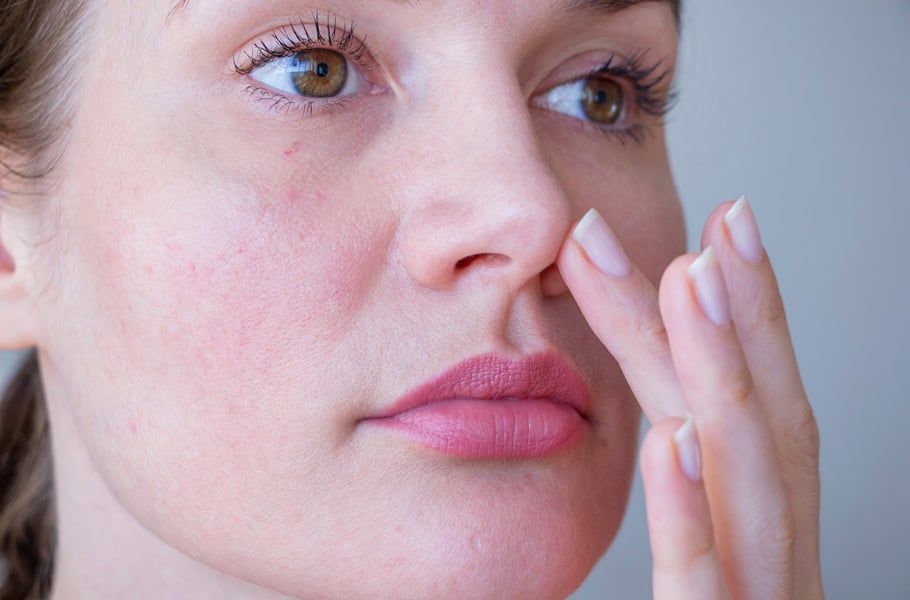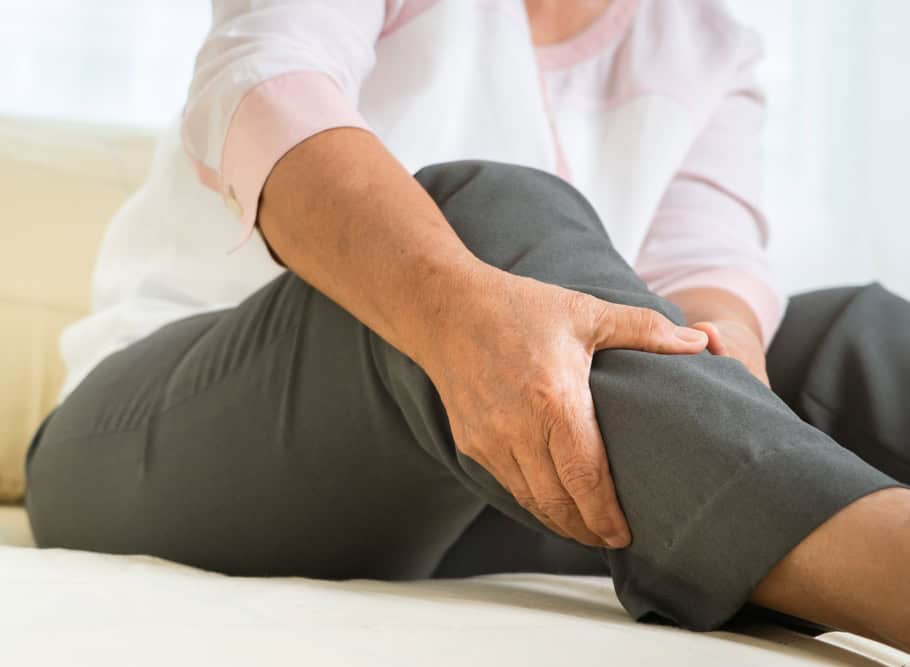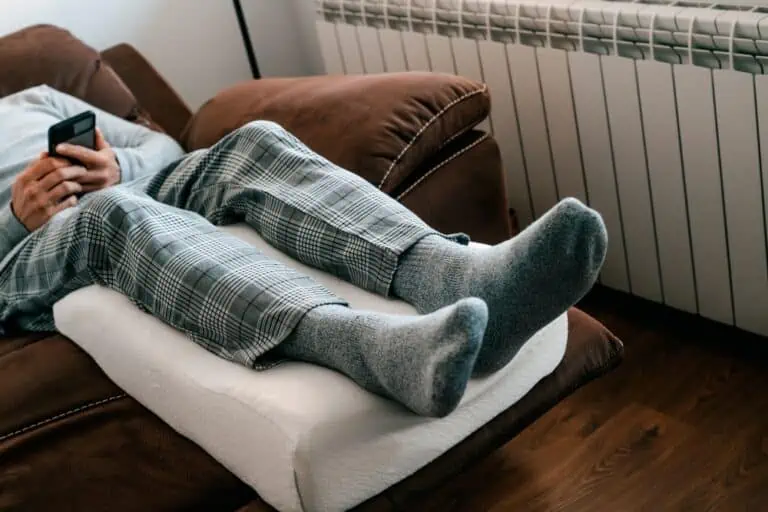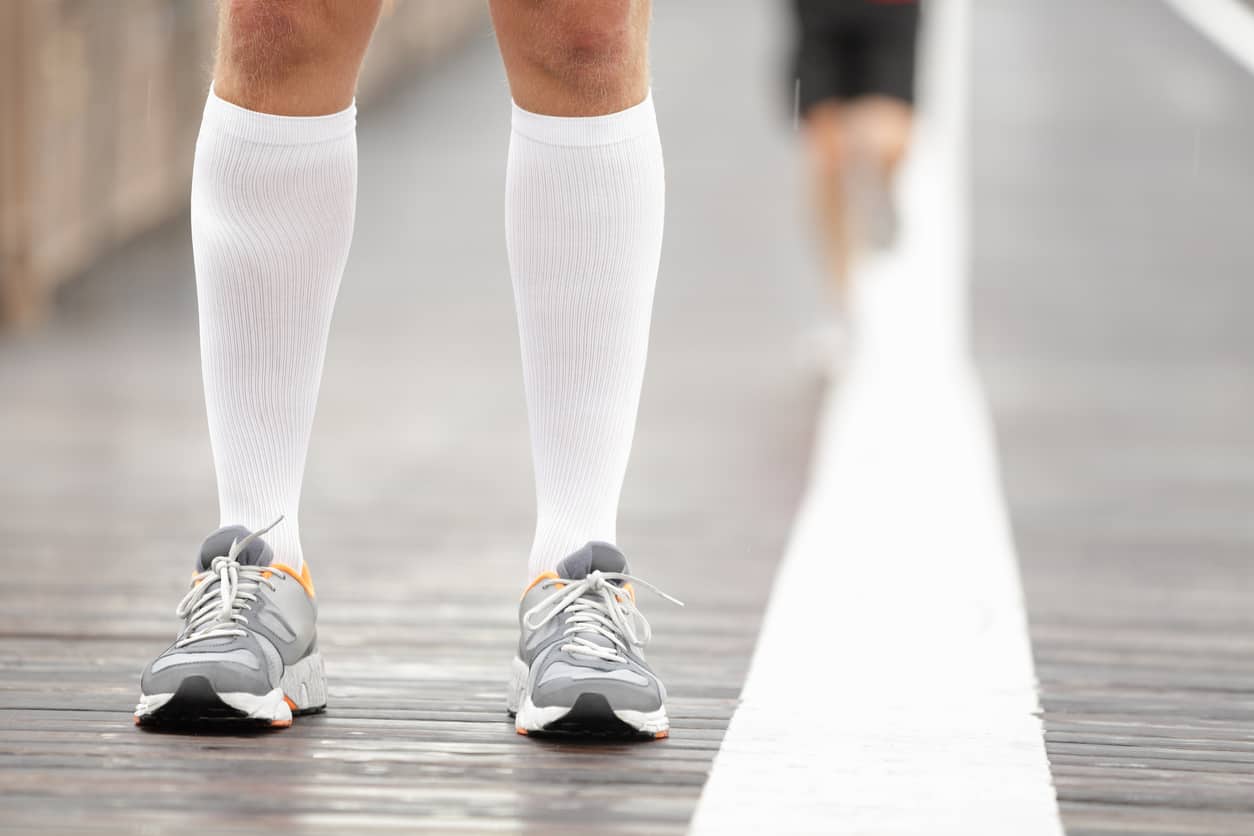Superficial Thrombophlebitis
Vein Condition
Superficial Thrombophlebitis
What is Superficial Thrombophlebitis?
If you have pain or tenderness along a vein near your skin, it could be a case of superficial thrombophlebitis. This condition, also called superficial venous thrombosis, happens when a vein near the surface of the skin becomes inflamed due to a blood clot. It usually affects a leg vein, but it can also happen in an arm or neck vein or wherever you’ve had an IV line or catheter inserted.
For example, a catheter in your hand could cause a blood clot that leads to superficial venous thrombosis. The skin over the vein may be red or warm, and the vein may feel hard, like a cord. Occasionally, the blocked vein can lead to infection.
FAQs
Most cases of superficial thrombophlebitis in the arm are caused by trauma to the vein or having an IV line or catheter in the vein. In the legs, the most common cause of thrombophlebitis is chronic venous insufficiency (CVI). In this vein disease, faulty valves in the leg veins allow blood to pool in the legs instead of returning to the heart.
You’re more at risk for superficial thrombophlebitis if you:
- Are inactive for long periods of time
- Have a pacemaker
- Are pregnant or recently gave birth
- Take birth control pills or hormone replacement medication
- Are over age 60
- Are overweight or obese
- Smoke
- Have varicose veins
- Have chronic venous insufficiency
- Have or had a stroke, cancer or blood clotting disorder
Superficial thrombophlebitis is usually more painful than dangerous. In rare instances, however, if it occurs in a large vein in the leg, it can lead to deep vein thrombosis (DVT). DVT is dangerous because if the blood clot breaks free, it can travel to the lungs and block the flow of blood. A blood clot in the lung (pulmonary embolism) is potentially fatal.
Exercise can be beneficial for superficial thrombophlebitis. Your vein doctor can tell you what types of activities are best for you.
Treatments for Superficial Thrombophlebitis
Most cases can be treated at home by applying warm compresses and elevating the affected area to reduce swelling. Taking over-the-counter nonsteroidal anti-inflammatory medication such as ibuprofen or naproxen can reduce the pain and inflammation. Most people recover in a week or two, though it may take longer if the vein has hardened, you’ve developed an infection or you have DVT.
Compression Therapy
Your vein specialist may recommend wearing compression stockings to ease the swelling. They’re available in different strengths and are sold over the counter, but it’s best to get a prescription from your vein physician to ensure they’re not too tight or too loose.
Blood Thinners
For more serious cases of superficial thrombophlebitis, a physician may prescribe a blood thinner to dissolve the clot. Surgery may be needed if blood thinners don’t work or you can’t take them.
Additional treatments
If you have varicose veins or chronic venous insufficiency, your AQUA Vein Center physician may suggest a minimally invasive procedure to close the problem veins and reduce your risk of developing more clots down the road.
If you suspect you have a vein problem, or if you have varicose veins, make an appointment at your nearest AQUA Vein Center to have one of our vein experts examine you and explain your treatment options.
How To Treat Bulging Hand Veins
Anyone can develop bulging veins in their hands, which make the hands look older. Fortunately, you don’t have to tolerate prominent hand veins if they make you self-conscious. Minimally invasive treatments can give you the smooth hands you’ve always wanted.
Spider Veins
Vein Condition
Spider Veins
What Are Spider Veins?
These squiggly red, blue or purple widened blood vessels near the surface of the skin are extremely common. About half of all women will develop them at some point, and men get them, too. Spider veins are not harmful to your health, but they may indicate a more serious problem. They can cause burning or discomfort, especially on the legs, and many people who have them don’t like the way they look.
FAQs
Like varicose veins, spider veins are often a sign of chronic venous insufficiency. In this condition, faulty valves in the veins allow some of the blood they carry to pool in the veins rather than returning to the heart. This pooled blood puts pressure on the veins, causing them to swell. The veins themselves can also lose elasticity, becoming wider and more stretched out than normal.
Several factors can contribute to their development, including family history, age, weight and your sex. Women are more likely to develop problem veins. Hormone fluctuations, which occur during menstruation, pregnancy and menopause, can increase your risk for circulation issues. Other factors that play a role are wearing high heels, sun exposure and injury.
Spider veins themselves are not harmful to your health. However, they may indicate that a more serious problem, such as venous insufficiency.
Spider veins can be very uncomfortable. “While some people seek treatment for them for cosmetic reasons, most want to remove them because they may itch and cause a throbbing, burning or heavy sensation,” said John Koziarski, MD, a board-certified general/vascular surgeon at AQUA Vein Center.
You can’t necessarily prevent spider veins, especially if they run in your family, but these measures can help you lower your risk:
- Wear compression socks or stockings if recommended by your doctor; they help minimize the pooling of blood in the skin of the legs
- Maintain a healthy weight
- Exercise regularly
- Take walking breaks if you have to stand or sit for long periods
- Wear low-heeled shoes
- Elevate your legs above your heart when you lie down
Treatments for Spider Veins
Treating the veins with a minimally invasive procedure causes them to close. Once they are closed, the body eventually absorbs them. The vein specialists at AQUA Vein Center are experts in spider vein treatment and successfully treat hundreds of spider vein patients each year.
During your vein consultation, one of our vein physicians will examine you, discuss your medical history and explain your treatment options.
Sclerotherapy
Sclerotherapy is the standard, preferred treatment for most spider veins. In this procedure, the physician uses a very thin needle to inject an irritating liquid or foam, known as a sclerosant, into the vein and its branch vessels. The sclerosant irritates the vein walls, which eventually causes the vein to collapse. Once it does, the body reroutes the blood through nearby veins.
Sclerotherapy for spider veins takes about 30 minutes per session. Most people need two or more sessions to treat all of their spider veins. You will feel a small pinch each time the needle goes in, but the procedure is not painful. The physician will recommend wearing compression socks or stockings for several days afterward to minimize bruising and improve results.
VeinGogh Ohmic Thermolysis System
This minimally invasive procedure is often recommended for spider veins that are too small to be treated with sclerotherapy, particularly spider veins on the face. In this procedure, bursts of radiofrequency energy are delivered from the tip of a tiny needle inserted just under the skin. The needle is as thin as a hair, so any discomfort is minimal.
Laser treatment
For veins that are too small for sclerotherapy or don’t respond, laser treatment is another option offered at AQUA Vein Center. This procedure uses a focused beam of light to close the spider veins, making them disappear by causing the blood in the vein to clot.
AQUA Vein Center specialists use state-of-the-art lasers such as the DORNIER Medilas D FlexiPulse 940 to provide the best possible outcome. You’ll need to stay out of the sun for several weeks after laser treatment to reduce your risk of developing brown spots in the treated area.
No matter which spider vein treatment you undergo, you can resume your normal activities right after your procedure.
What Causes Spider Veins?
While there are many risk factors, a common underlying cause is chronic venous insufficiency, when the valves in the veins become weakened and some of the blood leaks backward and pools.
How To Get Rid of Spider Veins on the Face
Unlike leg veins, spider veins on your face can’t be covered up with clothing — but they can be treated, typically without surgery.
Spider veins on the face are tiny burst blood vessels that can usually be treated with less invasive procedures.
Leg Swelling & Discoloration
Vein Condition
Leg Swelling & Discoloration
What is Leg Swelling & Discoloration?
Swelling in the legs and ankles and skin changes on your legs aren’t just uncomfortable. They are potential signs of an underlying venous disorder.
Discoloration can appear as reddish patches or brown-colored, thickened skin, often near the ankles. Skin issues can advance to venous ulcers that can be painful and difficult to treat.
These symptoms can worsen over time if not treated. Addressing the problem can increase the blood circulation in your legs and potentially spare you from more serious vein issues in the future.
What Causes Leg Swelling & Discoloration?
Leg swelling and discoloration are two of many symptoms caused when the one-way valves of the legs are damaged and the blood moves in both directions. When these valves don’t work well, blood flows backwards and collects in your legs.
The most common cause is chronic venous insufficiency (CVI). CVI develops due to dysfunctional valves, a blood clot (deep vein thrombosis) in the leg or an injury to the vein.
Other symptoms of CVI include:
- Tired and achy legs
- Pain when walking
- Leg cramps (especially at night) and muscle spasms
- Restless legs
- Leg skin that is flaky or itchy or has reddish patches
- Varicose veins
Treatments for Leg Swelling & Discoloration
After using ultrasound imaging to diagnose your faulty valves or CVI, your vein specialists have many common treatments to choose from to address them.
Compression Therapy
Your vein specialists will likely prescribe compression socks or stockings while they create your treatment plan. For some patients, compression wear alone may be enough to manage symptoms.
Radiofrequency Ablation or Endovenous Laser Treatment
Minimally invasive surgery can close a bad vein permanently and get you back on your feet quickly. Physicians often close the vein using heat in the form of radio waves (radiofrequency ablation, or RFA) or light (endovenous laser treatment, or EVLT).
VenaSeal
Another option is sealing the vein with a glue-like adhesive called VenaSeal. In rare cases, patients have a bad reaction to the adhesive, which then has to be surgically removed.
Sclerotherapy
In sclerotherapy, the physician injects a chemical into the vein that damages the lining, causing the vein to collapse.
When To Worry About Varicose Veins
Enlarged veins appear when the valves in the veins don’t work properly. If the valves become weakened or damaged, blood pools in the veins, causing them to swell, bulge and turn purple or blue. Varicose veins can develop anywhere, but they most often develop in the legs. That’s because leg veins have to fight gravity to get blood all the way up to the heart.
Heavy Legs
Vein Condition
Heavy Legs
What Are Heavy Legs?
Heavy legs and ankles create a feeling of fatigue and weakness. You may get a similar feeling when you exercise vigorously or are dehydrated, but those situations are temporary. But if your legs are heavy and achy all the time and you have visible spider and varicose veins, your symptoms may be caused by vein disease.
What Causes Heavy Legs?
Heavy legs can be caused by several conditions. The most common culprit is chronic venous insufficiency (CVI), a condition that occurs when the valves in your veins don’t work properly. Other possible causes include leg injury and peripheral artery disease (PAD), a type of cardiovascular disease that involves clogged arteries in the legs.
Treatments for Heavy Legs
Compression Therapy
In some cases, wearing snug-fitting compression socks or stockings can begin to ease leg heaviness in a matter of days. Your vein specialist can prescribe the right strength. The compression helps propel blood in the legs back to the heart. Your physician may also recommend elevating your legs for 30 minutes several times a day and walking more to improve blood circulation in the legs.
Radiofrequency Ablation, VenaSeal and Sclerotherapy
If the compression stockings help, it’s a sign that closing the faulty veins could relieve your heavy leg symptoms permanently. These veins can be closed using a quick, minimally invasive procedure. Options include laser treatment, radiofrequency ablation (closing the vein with heat), VenaSeal (a glue-like substance injected in the vein) and sclerotherapy.
The treatments are relatively painless and require little to no recovery time. Once a faulty vein is closed, the body reroutes the blood it carried to healthier veins nearby.
Why Do My Legs Feel Heavy and Tired?
Heaviness in the legs isn’t just an annoyance. It may be a symptom of a chronic medical condition involving poor circulation in the legs. A common culprit is chronic venous insufficiency (CVI), but other conditions can also be the cause.
Leg Lymphedema
Vein Condition
Leg Lymphedema
What Is Leg Lymphedema?
If your legs regularly feel heavy or achy and you experience leg swelling, lymphedema may be to blame. Lymphedema is an uncomfortable buildup of lymph fluid that can be chronic.
To understand lymphedema, first understand lymph fluid. It delivers nutrients to cells and tissues throughout the body via lymph vessels. It also collects their excess fluid and moves it back into the bloodstream.
In lymphedema, parts of the lymphatic system are damaged or blocked, causing lymphatic fluid to accumulate, typically in one arm or leg.
What Is Phlebolymphedema?
This is a form of lymphedema that stems from vein problems and usually affects both sides of the body. Circulation problems in the veins can affect the lymphatic system, and vice versa. In phlebolymphedema, also called venous lymphedema, the lymph system is damaged by severe chronic venous insufficiency (CVI).
In CVI, blood pools in the leg vein due to faulty one-way valves. That pooled blood increases pressure in the vein, causing fluid to leak out and build up in the space between the veins and the cells. This fluid is normally carried away by lymph vessels, but over time it overwhelms those vessels, damaging them. The result: Fluids from both the venous system and lymphatic system accumulate in the leg.
Anyone who has deep vein thrombosis (DVT), which is caused by a blood clot, is also vulnerable to phlebolymphedema.
FAQs
- Swelling on one arm or one leg
- A feeling of heaviness or tightness in the arm or leg
- Loss of range of motion in the arm or leg
- Leg swelling, which may be mild at first but can gradually become severe
- A feeling of fullness or heaviness in the legs
- Leg aching
- Thick, leathery skin
- Puffiness and redness of the skin
- Burning or itching
- Tight or inflexible joints
- Inability to see or feel the veins or tendons in the feet
Venous insufficiency and lymphedema are somewhat similar. Both are the result of poor drainage — of pooled blood in the first case and lymph fluid in the second. In phlebolymphedema, circulation problems in one system affect the other.
Treatments for Leg Lymphedema
Regardless of what’s triggering your leg swelling, it’s important to see a vein specialist right away to avoid complications, some of which may be life-threatening, and to prevent the lymph system from being damaged beyond repair.
Make an appointment to visit one of the vein care providers at AQUA Vein Center. Our specialists are experts at diagnosing phlebolymphedema and other vein-related conditions and can provide several types of treatments to help you feel better.
Compression Stockings and Lifestyle Changes
Since many of the symptoms of CVI, DVT and lymphedema are similar, certain treatments can help improve all three. For example, wearing prescription compression socks or stockings can improve blood and lymphatic fluid circulation. Your vein specialist may also recommend getting more exercise, regularly elevating your legs and avoiding crossing your legs.
For leg lymphedema, your care team may refer you to a healthcare practitioner trained in lymphatic drainage massage to help move the fluid out of your legs.
Closing Faulty Veins
AQUA Vein Center physicians can also ease leg heaviness and leg swelling with a minimally invasive procedure to close faulty veins, which stops the cycle of damage. They can close the veins using radiofrequency ablation (heat in the form of radio waves) or endovenous laser treatment (heat produced by light), or by injecting a glue-like substance called VenaSeal or an irritant solution (sclerosant). Once the faulty veins are closed, the body naturally reroutes the blood through nearby healthy veins.
Don’t wait for phlebolymphedema symptoms to resolve on their own, as there’s a good chance they won’t. Make an appointment today.
If you are experiencing any issues with your legs and would like to be examined by a vein specialist, call 800-836-1170 today to schedule your consultation.
What Causes Swollen Legs and When Should I Worry?
There are dozens of possible reasons for swollen legs — everything from sitting too long to serious heart or kidney problems.
If your legs, ankles or feet have started to look like sausages, learn the main causes of leg swelling and when to see a vein specialist.
Compression Therapy
Vein Treatment
Compression Therapy
What Is Compression Therapy?
This is a temporary, first-line therapy for venous reflux and vein disorders. It is often used as a preventative measure for many vein disorders.
Specially designed compression garments, including socks, bandages and wraps, support the veins by creating controlled pressure to increase blood circulation, decrease swelling and reduce the risk of more serious vein conditions.
Who Needs Compression Therapy?
Anyone with these common vein conditions will benefit from compression therapy:
- Swollen legs and ankles
- Chronic venous insufficiency (CVI)
- Deep vein thrombosis (DVT)
- Leg ulcers
People who are obese or pregnant may benefit from compression therapy. Many athletes wear compression garments to gain a competitive edge and prevent inflammation.
At AQUA Vein Center, most of our practitioners and staff wear compression garments daily — just ask them! You’ll be surprised when they show you the new, brightly colored compression sleeves, socks and stockings they’re wearing.
How To Use Compression Socks and Stockings
Today’s compression socks and compression stockings aren’t just for elderly adults with bad circulation. In fact, even athletes wear them.
If you stand for long periods or you have tired, heavy legs due to chronic venous insufficiency, you may notice a world of difference after wearing compression socks during the day.
Legs Feel Heavy? Leg Vein Treatment Can Help
If your legs feel heavy, even simple activities can be a slog. If you’re tired of living with heavy, aching legs and fatigue, leg vein treatment can “lighten the load” and put a new spring in your step.
Deep Vein Thrombosis
Vein Condition
Deep Vein Thrombosis
What Is Deep Vein Thrombosis?
Deep vein thrombosis or DVT, is when a blood clot forms in a deep vein (one that’s not near the skin).
DVT usually occurs in the leg but may occur in other areas including the arm or pelvis. It doesn’t always cause symptoms and often goes undiagnosed until there’s a serious complication. If a deep vein blood clot breaks free, it can travel the bloodstream and lodge in the heart or lung. This is a life-threatening situation.
Anyone who may have DVT should be evaluated and treated as soon as possible to prevent or minimize complications such as:
- Pulmonary embolism: A blood clot in the lung
- Post-thrombotic syndrome: Chronic pain, swelling and other symptoms
- Venous ulcers
- Chronic venous insufficiency (CVI)
FAQs
The most common causes of DVT are:
- Vein damage from surgery or trauma
- Inflammation due to infection or injury
- Medical conditions that affect how the blood clots
Another important risk factor is reduced mobility, such as from paralysis, a hospital stay, bed rest or even a long plane or car ride.
DVT is more common with age. Other risk factors include:
- Smoking
- Obesity
- A personal or family history of DVT or pulmonary embolism
- Pregnancy
- Oral contraceptives or hormone replacement therapy
- Dehydration
- Heart failure
- Inflammatory bowel disease
- Varicose veins
The more risk factors you have, the higher your risk of DVT. But sometimes, there’s no clear cause.
The most common signs and symptoms of DVT are:
- Swelling of the leg together with calf pain
- Skin that’s red and warm to the touch
About half of people with DVT have no obvious symptoms.
The most serious complication of DVT is a pulmonary embolism, which can cause:
- Breathing problems
- Chest pain that worsens with a deep breath
- Dizziness and fainting
- Rapid pulse and heartbeat
- Hemoptysis (coughing up blood)
A pulmonary embolism is a medical emergency. If you have symptoms of a PE, seek immediate medical care.
The doctor will ask about your symptoms and medical history and examine the affected area to check for redness, tenderness and swelling.
Tests that can help confirm or rule out DVT include:
- Duplex ultrasound, which uses sound waves to detect blood flow abnormalities
- Magnetic resonance venography (MRV), a type of MRI that produces three-dimensional images of veins
- D-dimer test, a blood test that can help rule out DVT. D-dimer is a protein produced by blood clots. Most people with DVT have a high level of D-dimer.
Because DVT is so common and often causes no symptoms, it’s been called a silent epidemic. These steps can help lower the chances of developing DVT:
- Don’t smoke.
- Exercise regularly.
- Manage your weight.
- Stay hydrated.
- Avoid tight-fitting clothing that can restrict blood flow, especially when traveling.
- If you’ve been in the hospital or on bed rest, start moving around as soon as you’re able.
- When traveling, drink plenty of water and avoid alcohol.
- Try not to sit still for too long. When possible, get up and move around at least once every hour or two.
- Avoid crossing your legs.
Try these exercises to promote blood flow while seated:
- Keeping your toes on the floor, raise and lower your heels 10 times. Then raise and lower your toes while keeping your heels on the floor.
- Tighten your calf muscles and hold for 5 seconds. Release and repeat several times.
- Lift one foot off the floor. Trace clockwise circles with your toes for a few seconds. Switch direction and repeat. Repeat with the other foot.
Talk to your doctor about your risk factors for DVT and how you can reduce your risk.
Treatments for Deep Vein Thrombosis
The goal of treatment is to prevent the clot from getting bigger or breaking loose and traveling to the lungs or heart. Your treatment plan will also include strategies to lower the chances of developing another DVT. Treatment options may include:
Anticoagulants (Blood Thinners)
These drugs help the body break up the clot. Blood thinners for DVT include oral, IV and injectable drugs. DVT patients may remain on them for months or years.
Vena Cava Filter
In an outpatient procedure, the physician inserts a tiny filter into the vena cava, the largest vein in the body. The device is left in place. If a blood clot breaks away, the filter will prevent it from reaching the lungs or heart.
Intravascular Ultrasound
Intravascular ultrasound (IVUS) is a noninvasive diagnostic imaging technique that uses sound waves to create detailed images of the inside of blood vessels. The technology can be used to evaluate veins in the legs, pelvis and abdomen.
Angioplasty and Vein Stent
If an abnormality of the vein is identified using IVUS, this is a treatment option. Angioplasty widens the vein with a balloon to improve the blood flow. Once the vein is widened, the surgeon may insert a wire mesh, or stent, to help keep it open.
Thrombolytics
These fast-acting, clot-busting drugs can be administered intravenously or directly into the clot through a catheter.
Venous Thrombectomy
In rare cases, a clot may be removed surgically.
If you have DVT or had it in the past, your vein specialist may recommend wearing compression stockings to help prevent blood from pooling or clotting.
What Causes Swollen Legs and When Should I Worry?
There are dozens of possible reasons for swollen legs — everything from sitting too long to serious heart or kidney problems.
If your legs, ankles or feet have started to look like sausages, learn the main causes of leg swelling and when to see a vein specialist.
Chronic Venous Insufficiency
Vein Condition
Chronic Venous Insufficiency
What is Chronic Venous Insufficiency (CVI)?
Chronic venous insufficiency (CVI) occurs when the tiny valves in the veins of the leg don’t work properly. Normally, these valves prevent blood that’s on its way to the heart from flowing back down the leg. When a valve is faulty, blood can pool in the vein and cause problems.
CVI in the main or axial veins in the legs is the most common cause of varicose veins. While CVI isn’t life-threatening, it can worsen quickly. If left untreated, the pain and swelling can become debilitating. CVI can also lead to open sores called ulcers.
If you have symptoms of CVI, book a vein consultation today. Early treatment can prevent the condition from progressing.
FAQs
CVI can cause changes in how the legs look and feel. Symptoms include:
- Varicose veins
- Swelling of the ankles and lower legs, particularly after standing for a long time
- Pain when walking
- Tired, achy legs
- Leg cramps and muscle spasms
- A tight feeling in the calves
- An urge to move the legs
- Leathery skin
- Flaky or itchy skin on the legs or feet
- Reddish patches on the lower legs that may progress to brown skin in severe cases
- Leg ulcers
Various factors may increase the risk of CVI, including:
- A family history of CVI
- Being overweight or obese
- Pregnancy
- Smoking
- Phlebitis (swelling and inflammation of a vein close to the skin)
- Damage to the leg from an injury or surgery
- Lack of exercise
- Tumors in the pelvis
CVI is more common in women, especially those who have had multiple pregnancies, and in people who are middle-aged or older. It can also develop after deep vein thrombosis, a blood clot in a deep vein of the leg.
Treatments for Chronic Venous Insufficiency
If your vein specialist suspects CVI, he or she may use ultrasound imaging to determine if one or more valves is defective.
Compression Therapy
Snug-fitting socks or stockings may be prescribed to increase circulation in the legs. For some patients, it may be all that’s needed.
Other patients will need treatment to close the affected veins so the body can reroute the blood through healthier veins. Today’s minimally invasive techniques leave virtually no scars and get you back on your feet quickly. It can take weeks or months for the full benefits of these procedures to take effect, but you may notice a difference sooner.
Endovenous Laser Treatment
Endovenous laser treatment (EVLT) uses laser energy to close faulty veins. A catheter (thin tube) is inserted into the vein, then a laser fiber is passed through it. The laser creates heat that causes the vein to collapse.
Radiofrequency Ablation
Like ELVT, radiofrequency ablation (RFA) uses heat to close faulty veins, but the heat is created by radio waves instead of a laser. Compared with EVLT, radiofrequency ablation often results in less post-surgery pain and bruising. AQUA Vein Center physicians use a radiofrequency ablation procedure called Venefit.
VenaSeal
The VenaSeal procedure seals the vein with a glue-like adhesive. Using ultrasound guidance, the physician inserts the device’s catheter into the vein and delivers small amounts of the adhesive. The procedure results in very little pain or bruising, and patients can return to normal activity immediately afterward.
The adhesive remains in the body permanently. In rare cases, a patient has a bad reaction to it and it must be surgically removed.
Sclerotherapy & Ultrasound-Guided Foam Sclerotherapy (UGS)
In sclerotherapy, faulty veins are closed by injecting an irritant solution (called a sclerosant) into the vein. Varithena is a brand of sclerosant foam. The physician may recommend sclerotherapy if you have varicose veins or spider veins in addition to CVI.
A vein specialist may first perform an ultrasound to locate the affected veins. Another option is to use a vein-finding device called Veinlite. The device emits light that is absorbed by blood in the veins, making the veins easier to see and allowing for more precise injections.
In some cases, the physician may use a special catheter called ClariVein to inject the irritant solution. ClariVein has a rotating wire tip that disperses the solution inside the vein.
Don’t Ignore the Symptoms of CVI
Do you have red or brown patches or visible veins on your legs? Don’t dismiss them as an age-related, cosmetic concern. They may be a symptom of chronic venous insufficiency.

